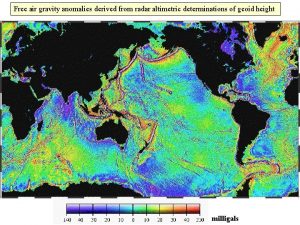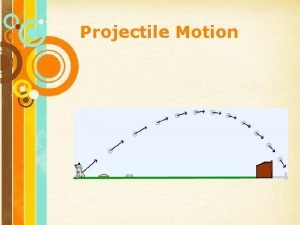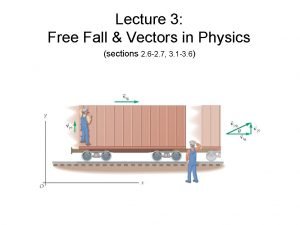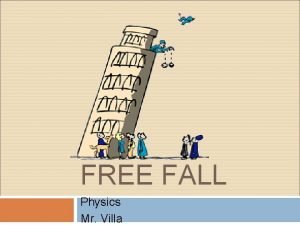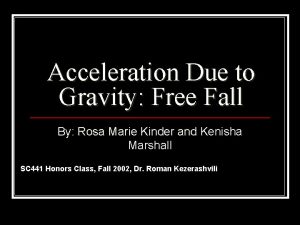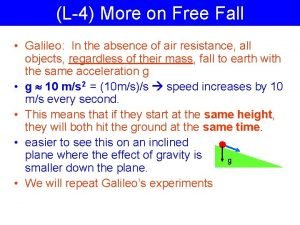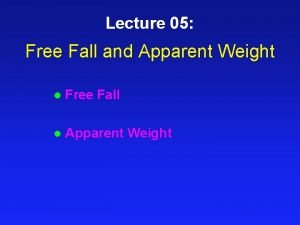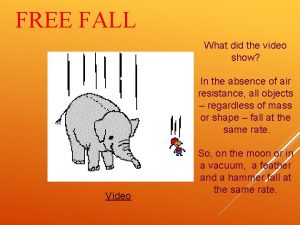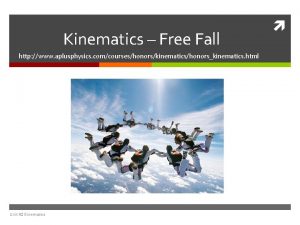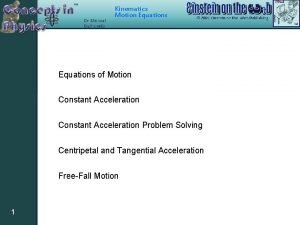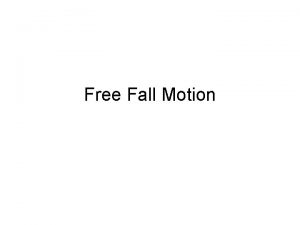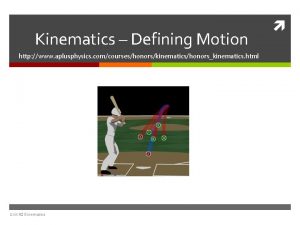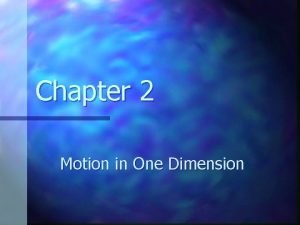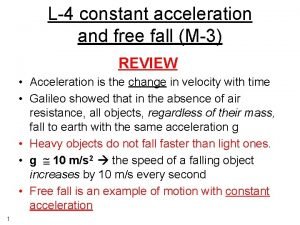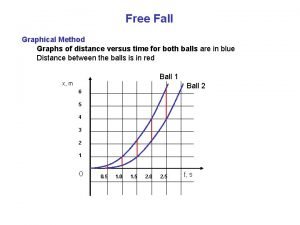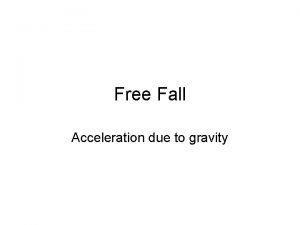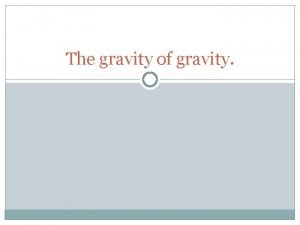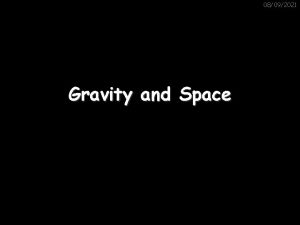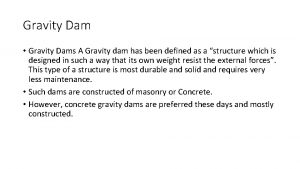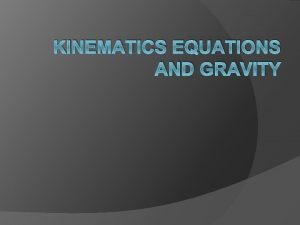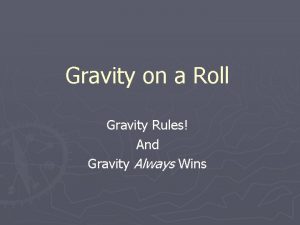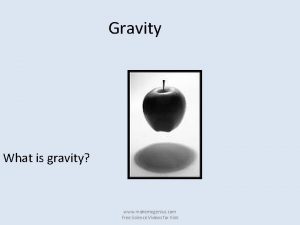Free Fall or Gravity is making me do





















- Slides: 21

Free Fall or Gravity is making me do it!!

What is free fall? • Free Fall is the motion of the body when air resistance is negligible and the action can be considered due to gravity alone. • Free fall Video

Acceleration Due to Gravity � Galileo concluded: � neglecting the effect of the air, all objects in free fall have the same acceleration. � It didn’t matter what they were made of, how much they weighed, what height they were dropped from, or whether they were dropped or thrown. � � The acceleration of falling objects, given a special symbol, g, is equal to 9. 80 m/s 2. We can use 10 m/s 2 in our calculations. The acceleration due to gravity is the acceleration of an object in free fall.

Acceleration Due to Gravity � � So…………………. . Object is in Free Fall when: � The only force acting on it is the force of gravity Its not touching other objects There is no air resistance (The vacuum that you can breath) � When on earth an object is in Free Fall � ay= -g =-9. 81 m/s 2 (or 10 m/s 2 for calculations) � Not on earth “little g” is different!!!!! gmercury= 3. 61 m/s 2 gmoon = 1. 62 m/s 2 (approx 1/6 of earth) gvenus= 8. 83 m/s 2 gmars = 3. 75 m/s 2

Acceleration Due to Gravity � � -g because acceleration is down…. its in the negative y direction However…acceleration due to gravity (g) is positive!!!! Its only when we talk about it in an xy system we say negative g varies from place to place on earth…However, for our problems we are going to assume a constant g so we can use our Uniform Accelerated Motion equations (kinematic equation). Pick a g (most cases 9. 81/10. 0 m/s 2) and stick with it (Global vs local. . . specific location) Little g is actually not called “gravity. ” g is the freefall acceleration.

If everything accelerates at the same rate, does that mean everything falls at the same rate? • • • Even they have a different weight? Yes Even if they are different sizes and shapes? Yes However, remember its YES as long as we do not include air resistance ( for example a feather falls at the same rate but is very affected by air resistance where the lacrosse ball is affected very little.

Free Fall � The figure shows the motion diagram for an object that was released from rest and falls freely. The diagram and the graph would be the same for all falling objects.

Question 1 � A ball is tossed straight up in the air. At its very highest point, the ball’s instantaneous acceleration ay is � Positive. � Negative. � Zero. © 2015 Pearson Education, Inc.

Question 2 � An arrow is launched vertically upward. It moves straight up to a maximum height, then falls to the ground. The trajectory of the arrow is noted. At which point of the trajectory is the arrow’s acceleration the greatest? The least? Ignore air resistance; the only force acting is gravity. © 2015 Pearson Education, Inc.

Question 3 � An arrow is launched vertically upward. It moves straight up to a maximum height, then falls to the ground. The trajectory of the arrow is noted. Which graph best represents the vertical velocity of the arrow as a function of time? Ignore air resistance; the only force acting is gravity.

Question 1 � A ball is tossed straight up in the air. At its very highest point, the ball’s instantaneous acceleration ay is � Positive. � Negative. � Zero. © 2015 Pearson Education, Inc.

Question 2 � An arrow is launched vertically upward. It moves straight up to a maximum height, then falls to the ground. The trajectory of the arrow is noted. At which point of the trajectory is the arrow’s acceleration the greatest? The least? Ignore air resistance; the only force acting is gravity. Same at all points. © 2015 Pearson Education, Inc.

Question 3 � An arrow is launched vertically upward. It moves straight up to a maximum height, then falls to the ground. The trajectory of the arrow is noted. Which graph best represents the vertical velocity of the arrow as a function of time? Ignore air resistance; the only force acting is gravity. D

Question 4: Analyzing a rock’s fall A heavy rock is dropped from rest at the top of a cliff and falls 100 m before hitting the ground. How long does the rock take to fall to the ground, and what is its velocity when it hits? Draw it……. . yi = 100 m.

Question 4: Analyzing a rock’s fall (cont. ) � Free fall is motion with constant acceleration: ay = g. . Using (vy)i = 0 m/s and ti = 0 s, we find � We can now solve for tf: � Now that we know the fall time, we can use the first kinematic equation to find (vy)f:

Question 5: Free Fall A ball is dropped from rest from the top of a building. Find: a) The instantaneous velocity of the ball after 6 sec. b) How far did the ball fall. c) The average velocity up to that point. Answers: -60 m/s, 180 m, -30 m/s

Question 6 Free Fall A hammer is dropped on the moon. It reaches the ground 1 s later. If the distance it fell was 0. 83 m: 1. Calculate the acceleration due to gravity on the surface of the moon. 2. Calculate the velocity with which the hammer reached the ground and compare to the velocity it would have, if it was dropped on the earth’s surface. Answer: -1. 66 m/s 2, -1. 66 m/s, -9. 8 m/s

Question 7 � Luke Autbeloe drops a pile of roof shingles from the top of a roof located 8. 52 meters above the ground. Determine the time required for the shingles to reach the ground.

Question 7 � � � � � An inspection of the four equations above reveals that the equation on the top left contains all four variables. d = vi t + ½ a t 2 Once the equation is identified and written down, the next step involves substituting known values into the equation and using proper algebraic steps to solve for the unknown information. This step is shown below. -8. 52 m = (0 m/s) • (t) + ½ • (-9. 8 m/s 2) • (t)2 -8. 52 m = (0 m) *(t) + (-4. 9 m/s 2) • (t)2 -8. 52 m = (-4. 9 m/s 2) • (t)2 (-8. 52 m)/(-4. 9 m/s 2) = t 2 1. 739 s 2 = t 2 t = 1. 32 s The solution above reveals that the shingles will fall for a time of 1. 32 seconds before hitting the ground. (Note that this value is rounded to the third digit. )

Question 8 � Rex Things throws his mother's crystal vase vertically upwards with an initial velocity of 26. 2 m/s. Determine the height to which the vase will rise above its initial height. Diagram: Given: Find: vi = 26. 2 m/s vf = 0 m/s d = ? ? a = -9. 8 m/s 2 vf 2 = vi 2 + 2 ad

Question 8 � � � � (0 m/s)2 = (26. 2 m/s)2 + 2 • (-9. 8 m/s 2) • d 0 m 2/s 2 = 686. 44 m 2/s 2 + (-19. 6 m/s 2) • d = 0 m 2/s 2 -686. 44 m 2/s 2 (-19. 6 m/s 2) • d = -686. 44 m 2/s 2 d = (-686. 44 m 2/s 2)/ (-19. 6 m/s 2) d = 35. 0 m The solution above reveals that the vase will travel upwards for a displacement of 35. 0 meters before reaching its peak. (Note that this value is rounded to the third digit. )
 Gravity for dummies and dummies for gravity equations
Gravity for dummies and dummies for gravity equations Free air gravity
Free air gravity Projectile motion ppt free download
Projectile motion ppt free download Fall vectors
Fall vectors Free fall
Free fall A 405-n rightward force
A 405-n rightward force What is the acceleration of free fall
What is the acceleration of free fall Usain bolt lebenslauf
Usain bolt lebenslauf Free fall
Free fall Apparent weight
Apparent weight Free fall
Free fall A coin is tossed vertically upward
A coin is tossed vertically upward Aplusphysics kinematics-free fall answers
Aplusphysics kinematics-free fall answers Free fall motion
Free fall motion Free fall acceleration
Free fall acceleration Kinematics-defining motion
Kinematics-defining motion A tennis player on serve tosses a ball straight up
A tennis player on serve tosses a ball straight up Free fall motion in one dimension
Free fall motion in one dimension Free fall acceleration
Free fall acceleration Free fall upward motion
Free fall upward motion Free fall
Free fall Free fall acceleration
Free fall acceleration

